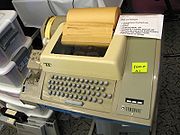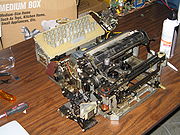
ASR33
Encyclopedia

Teleprinter
A teleprinter is a electromechanical typewriter that can be used to communicate typed messages from point to point and point to multipoint over a variety of communication channels that range from a simple electrical connection, such as a pair of wires, to the use of radio and microwave as the...
. Introduced about 1963 by Teletype Corporation
Teletype Corporation
The Teletype Corporation, a part of American Telephone and Telegraph Company's Western Electric manufacturing arm since 1930, came into being in 1928 when the Morkrum-Kleinschmidt Company changed its name to the name of its trademark equipment...
and designed for light-duty office use, it was less rugged and less expensive than earlier Teletype machines or its heavy-duty cousin, the Model 35-ASR.
The Model 33's printing mechanism was an array of levers, cranks, and a type cylinder
Cylinder (geometry)
A cylinder is one of the most basic curvilinear geometric shapes, the surface formed by the points at a fixed distance from a given line segment, the axis of the cylinder. The solid enclosed by this surface and by two planes perpendicular to the axis is also called a cylinder...
on a movable carriage. The Model 33 printed up to 10 characters per second. Printing was limited to the upper case ASCII
ASCII
The American Standard Code for Information Interchange is a character-encoding scheme based on the ordering of the English alphabet. ASCII codes represent text in computers, communications equipment, and other devices that use text...
character set.
"ASR" stood for "automatic send and receive." The ASR-33 had a built in paper tape reader and tape punch and used eight-bit ASCII code including one parity bit
Parity bit
A parity bit is a bit that is added to ensure that the number of bits with the value one in a set of bits is even or odd. Parity bits are used as the simplest form of error detecting code....
. It could print and read or punch tape at the speed of ten characters per second. The ASR-33 tape reader was purely mechanical; eight spring-loaded probes would be thrust into the tape, one character at a time, and an assortment of rods and levers would sense how high the probe rose, which told it whether there was a hole in the tape at that position.
The paper tape reader is on the lower left and the paper tape punch is directly above it. As it exits the machine, the tape passes under a triangular lip that allows the tape to be easily torn by lifting against the sharp edge of the lip.
Related machines
The ASR-32 was a similar device, but used five-hole Baudot codeBaudot code
The Baudot code, invented by Émile Baudot, is a character set predating EBCDIC and ASCII. It was the predecessor to the International Telegraph Alphabet No 2 , the teleprinter code in use until the advent of ASCII. Each character in the alphabet is represented by a series of bits, sent over a...
and had a three-row keyboard. The otherwise identical KSR-33 and KSR-32 models ("Keyboard Send and Receive
Keyboard Send Receive
Keyboard send receive is part of a designation for a series of hard-copy teleprinters, manufactured by Teletype Corporation. The KSR range were lower cost versions of the ASR models. These models included, but were not limited to the Model 28 KSR, the Model 32 KSR, the Model 33 KSR and the Model...
") lacked the paper tape reader and punch. RO-33 and RO-32 models ("Receive Only") had neither keyboard nor reader/punch.
The Model 33 could accommodate an internal modem
Modem
A modem is a device that modulates an analog carrier signal to encode digital information, and also demodulates such a carrier signal to decode the transmitted information. The goal is to produce a signal that can be transmitted easily and decoded to reproduce the original digital data...
with an optional acoustic coupler
Acoustic coupler
In telecommunications, the term acoustic coupler has the following meanings:# An interface device for coupling electrical signals by acoustical means—usually into and out of a telephone instrument....
to the right of the keyboard. This was replaced by a blank panel on units operating on a current loop.
In the 1960s and early 1970s minicomputer
Minicomputer
A minicomputer is a class of multi-user computers that lies in the middle range of the computing spectrum, in between the largest multi-user systems and the smallest single-user systems...
s typically had a 20mA current loop
Current loop
A current loop describes two different electrical signalling schemes.- Digital :For digital serial communications, a current loop is a communication interface that uses current instead of voltage for signaling...
interface for connection to a 33 ASR teletype used as a console terminal and paper tape program loader. A Model 33 cost about $700, much less than early video terminals such as the Tektronix 4010. As the price of electronic terminals dropped in the late 1970s, the current loop was gradually replaced by an RS-232
RS-232
In telecommunications, RS-232 is the traditional name for a series of standards for serial binary single-ended data and control signals connecting between a DTE and a DCE . It is commonly used in computer serial ports...
interface.
More expensive Teletype systems used photo readers that used light sensors to detect the presence or absence of punched holes in the tape. These could work at much higher speeds (hundreds of characters per second). More sophisticated punches were also available that could run at somewhat higher speeds; Teletype's BRPE punch could run at 60 characters per second.
Basic CRT
Cathode ray tube
The cathode ray tube is a vacuum tube containing an electron gun and a fluorescent screen used to view images. It has a means to accelerate and deflect the electron beam onto the fluorescent screen to create the images. The image may represent electrical waveforms , pictures , radar targets and...
-based computer terminals which could only print lines and scroll them are often called glass teletypes or dumb terminals to distinguish them from more sophisticated devices. Teletypes were gradually replaced in new installations by dot-matrix printers and CRT based terminals in the mid to late 1970s.
Historical impact

- The programming language BASICBASICBASIC is a family of general-purpose, high-level programming languages whose design philosophy emphasizes ease of use - the name is an acronym from Beginner's All-purpose Symbolic Instruction Code....
was designed to be written and edited on slow model 33 teletypes. The slow speed of 33 teletypes also influenced the user interface of minicomputer operating systems, including UNIXUnixUnix is a multitasking, multi-user computer operating system originally developed in 1969 by a group of AT&T employees at Bell Labs, including Ken Thompson, Dennis Ritchie, Brian Kernighan, Douglas McIlroy, and Joe Ossanna...
. - An ASR-33 provided Bill GatesBill GatesWilliam Henry "Bill" Gates III is an American business magnate, investor, philanthropist, and author. Gates is the former CEO and current chairman of Microsoft, the software company he founded with Paul Allen...
' first computing experience. - In 1971 Ray TomlinsonRay TomlinsonRaymond Samuel Tomlinson is a programmer who implemented an email system in 1971 on the ARPANET. Email had been previously sent on other networks such as AUTODIN and PLATO. It was the first system able to send mail between users on different hosts connected to the ARPAnet...
chose the @ symbol on his ASR-33 keyboard for use in network emailEmailElectronic mail, commonly known as email or e-mail, is a method of exchanging digital messages from an author to one or more recipients. Modern email operates across the Internet or other computer networks. Some early email systems required that the author and the recipient both be online at the...
. - An ASR-33 had a cameo appearance in the 1994 Coen brothers comedy film, the Hudsucker Proxy (although the film was set in 1958 and the ASR-33 did not roll out until 1962/63).

